Fire or life threatening emergencies: 000
Emergency Information: 13 3337
SES Emergency Assistance: 132 500
Discover over 125 years of fire brigade history at the heritage-listed Old Central Fire Station. Perth’s first purpose-built fire station is now a Heritage Centre and offers fascinating displays of historic firefighting equipment, vintage fire trucks, and captivating tales of firefighter antics!
Children and the young at heart can gear up as firefighters, pose on our iconic fire pole, and take the wheel of an authentic fire truck.
Located in Perth’s historic East End, the Old Central Fire Station is the perfect venue for history enthusiasts and families looking for a fun trip into the city. Ignite your curiosity and visit us today!

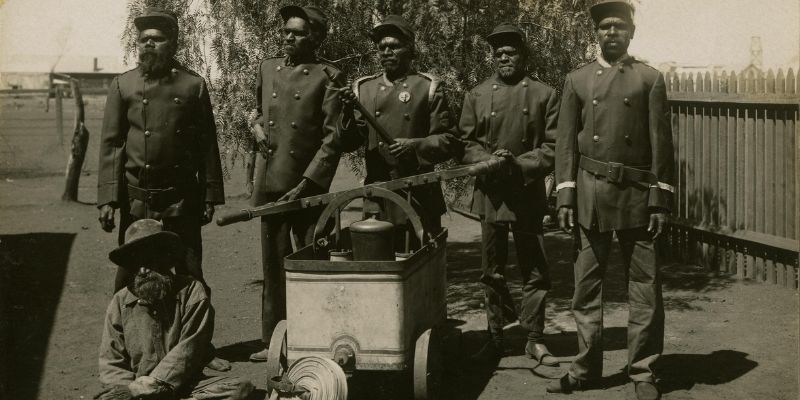
DFES acknowledges the Aboriginal peoples throughout the state of Western Australia as the Traditional Custodians of the lands where we live, work and volunteer. We recognise Aboriginal peoples’ continued connection to land, waters, and community, and pay our respects to Elders both past and present.
Old Central Fire Station is situated within Boorloo (Perth) the traditional land of the Whadjuk people of the Nyoongar nation.
Image: Kookynie Fire Brigade, c1900. PH2004.001
The Whadjuk Noongar have very strong katitjin (knowledge) connections between karla and boodjar (country).
Only Whadjuk Nooongar with responsibility for boodjar can burn it. This burning, known as fire-stick farming, took place during Birak (December–January). It removed the build-up of undergrowth and ensured that there was new growth for humans and animals (particularly kangaroos) to use and eat. Fire was used during hunting to flush out kangaroos and other game, making them easy targets.
Although the cultural setting has changed since European settlement, fire remains a dominant force on the natural landscape and a real threat to our community.
Organised fire brigades were introduced in Western Australia in the late 1890s to protect its people, towns, cities and landscape. Records show that aboriginal people living in local townships often joined volunteer fire brigades to help keep their people safe.
The Bushfire Centre of Excellence has established a Cultural Fire Program to consider how we can better link contemporary fire management with traditional fire practices.

No fire station would be complete without fire trucks.
Our 1921 Dennis Light Pumper, which was in service from 1923 to 1969, is on permanent display. We also have a regular rotation of other appliances from the DFES Vintage Fleet.
For a fun photo opportunity available to all ages, you can even dress up in a firefighter uniform and sit at the wheel of a real fire truck, our Scania Medium Pumper.

Immerse yourself in the history of WA’s fire service and see how appliances, equipment and uniforms have changed over the years.
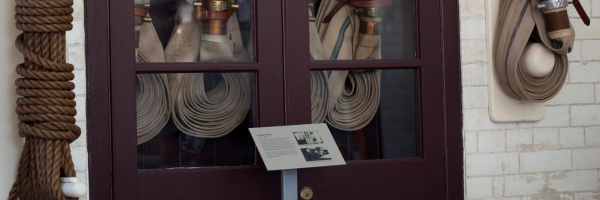
Follow the stainless steel plaques around the Centre and imagine what it would have been like to work and live in WA’s first purpose built fire station, which operated between 1901 and 1979.

Learn about the various hazards that affect our State, including home fires, bushfires, tsunamis, cyclones, storms and floods.

Sit down with the kids and read from one of our books relating to emergency services. There is also a colour-in station, plus puzzles and jigsaws to play with.
Old Central Fire Station Heritage Centre welcomes visitors of all abilities and ages. We aim to provide an inclusive, accessible and enjoyable experience for everyone.
Please use the information below to help plan your visit and don’t hesitate to contact us with any questions.

The centre is located at 25 Murray Street in Perth’s East End.
Our neighbours are Hibernian Place and Royal Perth Hospital Heritage Precinct and Museum.
When travelling to the Centre, we encourage the use of public transport.
Train: The Centre is within close walking distance from Perth, Perth Underground and McIver train stations.
Bus: It is a slightly longer walk from the Wellington Street and Elizabeth Quay bus stations to the Centre. A free transit zone operates within the City of Perth boundaries, allowing free travel on any bus within the City of Perth.
We can also be reached via the free Red CAT bus. Disembark at the Royal Perth Hospital (Stop 26) which is a stop after you pass the Centre on your right.
To plan your journey, please visit the Transperth website.
Transperth Education can assist schools in planning their public transport journey.
There is no car parking available at the Centre.
The closest public car parking is available at the City of Perth Fire Station and Pier Street car parks.
The Pier Street car park currently offers 3-hours of free parking on weekends.
For more information, including ACROD parking, head to the Visit Perth website.
There are no dedicated parking spaces, however there is a drop-off and pick-up zone located on Murray St, just after the Pier St intersection (look for the Red CAT bus stop). From this zone, it is a short 2-3 minute walk to the Centre.
Mini buses may find parking at the Terrace Road Car Park
Old Central Fire Station is closed for the Holidays. We reopen on Tuesday 6 January.
The Heritage Centre is open from 9.30am until 2.00pm on the following days:
Please refer to the Activities and events section for additional opening hours.
We are closed on all public holidays, including Easter Saturday.
In 2026, we are open on the following Saturdays:
Tickets are not required for general entry, but may be required for special events. Bookings are essential for groups.
If you enjoyed your visit, please consider making a donation to your local volunteer emergency service.
All general public entry points have universal access. The first floor can be accessed via stairs or the lift.
Assistance animals trained to assist people with disabilities are welcome
Changing facilities are available in the universal access toilet.
We do not have a cloaking facility. Please leave large bags or items at home.
For the latest COVID-19 information, please visit wa.gov.au
If you require assistance while at the Centre, please ask one of our volunteers to request a trained first aid officer. There is also a defibrillator on site.
Food and drink (excluding bottled water) are not permitted inside the Centre. There is no onsite café but there are several nearby.
You are welcome to picnic in nearby Hibernian Place.
A guide to the galleries can be collected from the Information Desk or downloaded.
Located at the main entry.
Located at the Information Desk.
Allowed unless otherwise stated. Photography and filming for commercial purposes (including weddings) must have written approval from DFES.
Due to space limitations, we encourage prams to be parked at the entry. Please note, prams are parked at the owner's own risk.
The Centre tends to be quieter after 1pm (excluding school holidays).
There is seating available in the gallery spaces.
There is no shop at the Centre. Please ask at the Information Desk for your free sticker and a copy of our souvenir book 120 Years of Fire Service History.
The Centre and the neighbouring Hibernian Place are both non-smoking sites.
Toilet facilities are available at the Centre, including universal access.
Public Wi-Fi is available. Please ask at the Information Desk for the password.
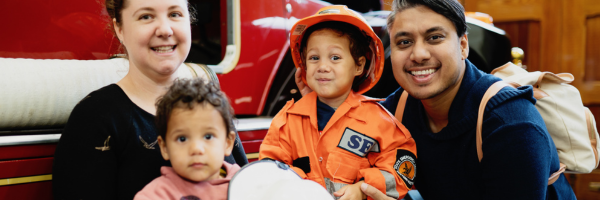
The Old Central Fire Station is a great place for the whole family to explore and enjoy during the school holidays.
Dates: Tue 6, Wed 7, Thu 8, Tue 13, Wed 14, Thu 15, Sat 16, Tue 20, Wed 21, Wed 22, Tue 27, Wed 28, Thu 29 January
Cost: Free
Visit Old Central Fire Station these summer school holidays and every young visitor will receive their very own Be Safe in an Emergency activity booklet – packed with puzzles, mazes and fun challenges - to take home.
We welcome vacation care groups to visit the Centre during the school holidays.
These visits are free of charge, self-guided and generally last an hour.
It is essential that all groups book using our online booking request form.
We thank the students from Mercedes College who assist us during the school holidays as part of the College’s Mercy Service program.

Join a volunteer Gallery Guide as they take you on a 30-minute walk around our heritage-listed building. Together you will explore the history of the building’s former life as a fire station. No two walks are ever the same.
Ask at the Information Desk for availability.

Fireman Jack was the winner of the Professor David Dolan Award at the 2025 Western Australian Heritage Awards. Find out more.
Perth’s historic Murray St East neighbourhood is home to one of the city’s richest collections of late 19th and early 20th-century heritage-listed buildings — many still serving their original purpose! From a grand cathedral and palace to a bustling school, hospital, fire station, and government departments, history is alive here.
Stepping Back with Fireman Jack takes you on a personal journey through the past, told through the eyes of a retiring firefighter in 1930. Along the way, you’ll uncover the people, places, and moments that shaped this neighbourhood.
Get your free trail map at the Old Central Fire Station or the iCity Visitor Kiosk in the Murray Street Mall.
Prefer exploring on your phone? Follow the trail on the Perth Trails App, featuring narration by Mark Gibson from ABC Perth Breakfast!
Download the App
App Store
Google Play
Stroll at your own pace and let Jack’s voice bring our neighbourhoods past to life!
Stepping Back with Fireman Jack is an official activity of the Boorloo Heritage Festival and Australian Heritage Festival in 2025.
Disclaimer: Stepping Back with Fireman Jack is a historical interpretation designed to bring the past to life through storytelling. While based on historical events and figures, the trail presents a fictionalised perspective through the eyes of a retiring firefighter in 1930. Some details have been adapted for narrative flow and engagement. This trail reflects the language and attitudes of the time and may not align with contemporary values. It aims to provide insight into Perth’s past while respecting the people and cultures who shaped it.
Images: All images featured in this trail have been used with permission. Full credits are available here.
Acknowledgements:
The trail content was developed by the staff and volunteers of Old Central Fire Station Heritage Centre in collaboration with Alex Kopp of Writilin.
Valuable assistance was provided by:
The Perth Trails App was produced by the City of Perth.
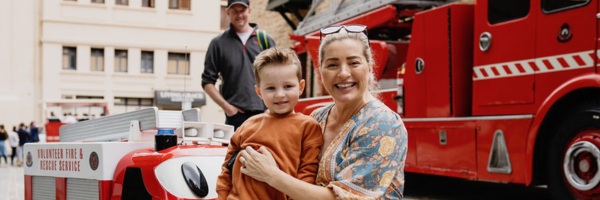
Date: Saturday 12 April 2025
Time: 9am – 2pm
Join in the fun at Old Central Fire Station’s Family Heritage Day!
Get ready for a day packed with heritage, hands-on history, and a sprinkle of mischief!
Best of all - everything is FREE!
Here’s what’s in store:
Bonus: All families who register will receive a Be Safe in an Emergency activity book!
Picking a time slot helps us plan - stay as long as you like, but mornings are busiest!
We can’t wait to see you at Old Central Fire Station!

At 1pm each day, the balcony doors are opened so that our visitors can check out the area where firefighters relaxed and slept.
Tip: While you’re out there, ask a volunteer about the old fig tree. They might share a story or two that may be more legend than truth!

Dates: 7 Feb, 7 Mar, 4 Apr, 2 May, 6 Jun, 4 Jul, 1 Aug, 5 Sep, 3 Oct, 7 Nov, 5 Dec
Time: 9:00am – 10:00am
Cost: Free
On the first Saturday of the month we host an early access session to support children with sensory needs and their families to explore and enjoy the Old Central Fire Station.
What you can expect:
Bookings:
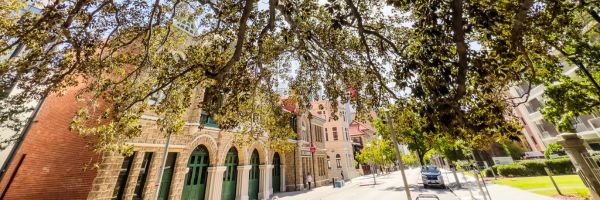
After your visit explore our neighbourhood with our family-friendly I Spy Trail.
Follow the trail and keep your eyes wide open to spot the interesting things hidden around you. Don’t forget to look up, down, and all around you as you explore the sights.
Look, touch, sniff – but no licking or picking! Happy spotting!
Pickup your I Spy Trail on your way out and you can view it online before you visit here.
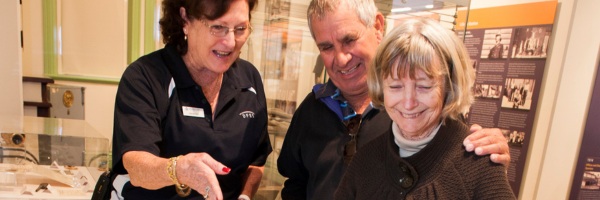
In celebration of WA Seniors Week 2024, we’re offering something special! Join us for a Heritage Highlights Tour combined with our brand-new Home Fire Safety Chat with a Cuppa program.
Start with a leisurely 30-minute guided stroll through the station, led by one of our knowledgeable volunteers. Then, settle in with a comforting cup of tea as we discuss practical home fire safety tips.
Date: Wednesday 13 November 2024
Morning Session: 10:00am – 11:30am
Afternoon Session: 1:00pm – 2:30pm
Cost: Free
Bookings: Click here to book a place
Whether you’re attending solo or with friends, this event is designed just for you.
Interested in bringing a larger group? We also offer Heritage Highlight Tours for senior groups - click here to learn more.

From students and Scouts to seniors and community groups, a visit to the Old Central Fire Station Heritage Centre offers a unique blend of fun and learning that engages visitors of all ages and abilities.
Whether you're exploring history, learning about emergency preparedness, or simply enjoying a memorable outing, a group visit to the Centre promises an enriching experience that’s both educational and enjoyable for everyone involved.
Group booking requests are now done quickly and easily online.

We welcome visits from preschools, kindergartens, childcare centres and playgroups with children at least three years old.
Children will be welcomed by one of our friendly volunteers and encouraged to dress up as an emergency helper, sit in a real fire truck and play with puzzles in the Kids’ Corner. The Kids’ Corner is also available for group leaders to read to the group.
These visits are free of charge, self-guided and last approximately one hour.
We welcome students from all year groups for a free self-guided excursion.
Self-guided excursions are available on Tuesday, Wednesday, and Thursday during term time.
These visits generally last an hour and are available at 10am, 11am, 12pm or 1pm.
Self-guided visits include an introductory welcome from our volunteers. Students can also participate in the volunteer demonstrations around the Centre that have been scheduled that day.
The Centre has discontinued the educator-led Emergency Helpers and Home Fire Safety excursions. Educational resources are available for teachers to use in the classroom on these themes.
Excursion Management Plan
The Excursion Management Plan provides further information to help you plan your excursion to the Centre.
Excursion Management Plan – PDF (250kb)
Public Liability Certificate of Currency – PDF (36kb)
Bookings are essential.
We welcome bookings from all other groups in the community.
Small group bookings can request a volunteer-led walkthrough, which can often be tailored to suit the interests of the group.
You may like to extend your stay in the city by visiting the Royal Perth Hospital Museum or take the Historic Heart of Perth’s Architecture or Small museums walk.
Vacation care and youth groups are welcome to visit the Centre on Saturdays and Tuesday to Thursday during the school holidays.
Spend the day in the city and visit another cultural attraction or let the kids play outside at Koolangka Koolangka Waabiny (Wellington Square Playground).
These visits are free of charge, self-guided and last approximately one hour.

Bookings are essential for all groups that wish to visit the Centre.
Group bookings can be made online using the booking request form.
The booking request form contains the available dates and the standard booking slot times. We allow modifications to the start time, as long as the adjacent slot isn’t already booked. Please note this request in the special considerations box.
If you have any questions, special requests or need to make a modification to an existing booking please email oldcentral@dfes.wa.gov.au
Excursion Management Plan
The Excursion Management Plan was developed to assist schools in preparing for an excursion, but it provides useful information for all groups in planning a visit to the Centre.
Excursion Management Plan – PDF (250kb)
Public Liability Certificate of Currency – PDF (36kb)
Do you have a passion for WA history and Perth’s much-loved heritage-listed buildings? Perhaps you’re technological minded and would like to share your knowledge on our historic and modern fire appliances and firefighting equipment? Or maybe you just want to drive an old fire truck?
If one or more of the above sounds like you might like to become involved with one of our volunteer programs! See below for current opportunities.
Our volunteers are proud members of the registered Education and Heritage Volunteer Fire and Emergency Services (VFES) unit.
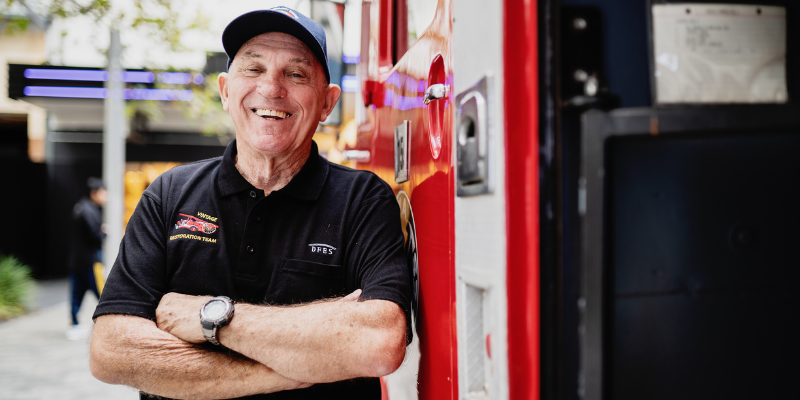
Our front-of-house volunteers are the enthusiastic and friendly faces that welcome visitors when they first arrive at the Centre.
You’ll also find them in the galleries delivering amazing tours and demonstrations and sharing stories of our little piece of history in the historic East End.
Front-of-house volunteering is offered one day a week or fortnight, with a commitment of 12 months or more.
New volunteers are recruited every 6 – 12 months.
Click here to find out more or submit an expression of interest.
Volunteering behind-the-scenes is a rare opportunity to work with the DFES Heritage Collection.
Volunteers may assist with sorting, data entry, cataloguing, labelling, cross-checking, shelving or helping with research.
Front-of-house volunteering is offered one or more days a week or fortnight, with a commitment of 12 months or more.
Some knowledge of the WA fire service or computing skills may be an advantage but not essential. Good communication skills and attention to detail are important.
Behind-the-scenes volunteers are recruited as needed to fill skill gaps within the team.
Click here to find out more or submit an expression of interest.
Ever wanted to drive a vintage fire truck? Join the Heritage Fleet Team, and that dream might come true!
We are currently seeking volunteers for the following two teams:
The Restoration Team meet at the DFES Academy on Mondays and requires a weekly or fortnightly attendance.
The Driver Team offers more flexibility but requires a commitment to complete some in-house driver training and attend at least six events per year.
Click here to find out more or submit an expression of interest.
The heritage-listed Old Central Fire Station is home to the DFES Heritage Collection and Fleet. Through this collection, we bring the station's rich history of firefighting to life.
This vibrant history is preserved and shared through ongoing research and care, thanks to the dedication of volunteers. Their passion and commitment ensure that the stories of Western Australia’s firefighting legacy continue to inspire and educate visitors for generations to come.
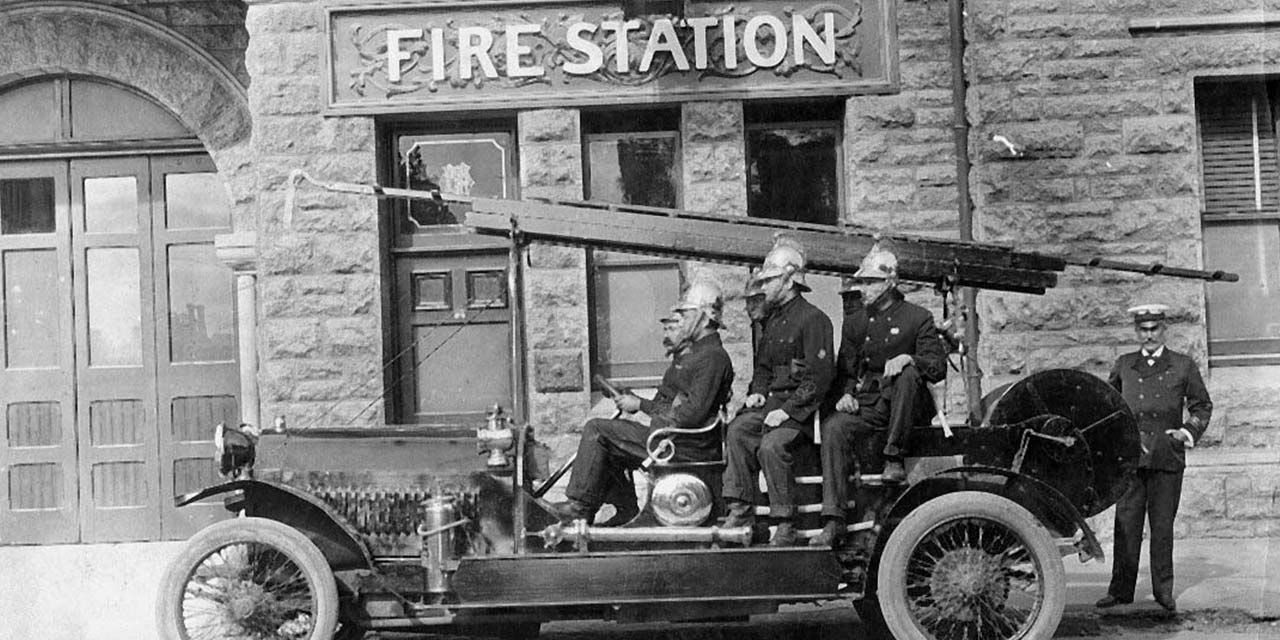

From 1885 the Fire Brigade operated from the undercroft area of the Perth Town Hall on Barrack Street. With the discovery of gold in the 1890s causing a growth in population there was a need for a new dedicated fire station.
An alternate Perth site was selected on the corner of Murray and Irwin Streets and the station was constructed during 1900. Designed by architects Cavanagh and Cavanagh, the new two-storey building was Romanesque in style, with rusticated limestone walls and a red-tiled roof.
The new technologically advanced station became operational on 1 January 1901. The large engine room had three exits and held two large steamers and two hose carts, which doubled the equipment with which the brigade had previously been working. When a call was received, an officer pressed a button, which set the alarms ringing, flooded the building with electric light, and opened the trap doors in the ceilings to clear the sliding poles.
Over the next 78 years of operation, Perth Central Fire Station undertook major architectural changes to support and accommodate increasing permanent staff numbers as well as technological change in fire appliances.
The Perth Central Fire Station was decommissioned in 1979, but still continues to serve the community of WA through the DFES Education and Heritage Centre.
In 2008, the building was registered permanently on the WA Heritage Register.
In 2020 a booklet documenting the 120 year history of the Perth Central Fire Station was published. A free copy of the booklet can be collected from the Centre or downloaded.
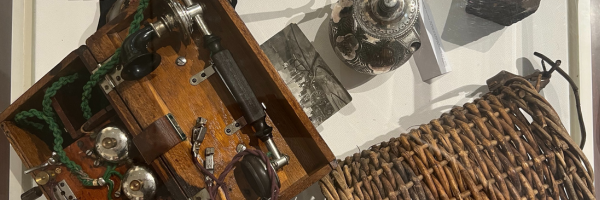
Housed within the Centre is DFES’ Heritage Collection. The Collection was established on behalf of the people of WA and helps to tell the cultural and technological history of the fire and rescue services in our State.
The Collection includes over 3,000 objects consisting of artefacts, fire appliances, artworks, ephemera, books, documents, microfiche, audio-visual records and photographs.
It also holds a significant archive of fire station occurrence books that record the day-to-day running of the station.
Search the Collection
Part of the Collection is now publicly available online via the eHive platform. We invite you to explore and share the objects and photographs. Each record has the option to leave a comment, so please do if you identify a person in a photograph or have an interesting story to share. Explore now.
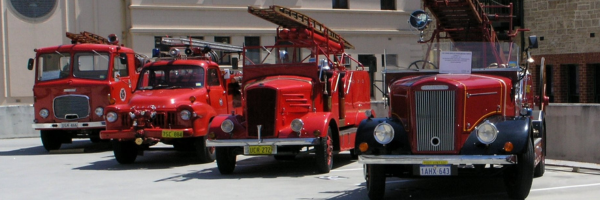
The Heritage Fleet features a variety of decommissioned fire appliances that showcase the evolution of fire technology used by the Fire and Rescue Service of Western Australia. Appliances in the Heritage Fleet include:
Find out more about our Heritage Fleet appliances on eHive.
The Heritage Fleet can often be seen at DFES ceremonial events, as well as at community events such as the annual Perth Christmas Pageant.
The Heritage Fleet is maintained by a dedicated group of volunteers, many of whom are former firefighters. Find out more and submit an expression of interest.
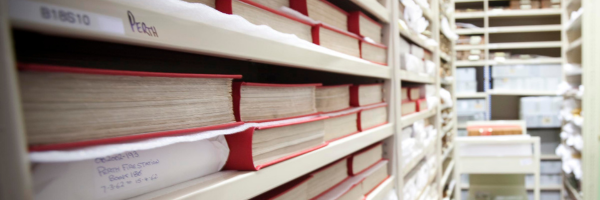
All heritage enquiries, including donation offers and research requests, should be submitted in writing to educationandheritage@dfes.wa.gov.au. Please note that research requests are processed by a small dedicated team of volunteers. Response times may vary depending on the complexity of the request and their current research priorities.

The W.A. Bush Fire Museum and Heritage Group is devoted to the preservation of the history heritage and history of bush fire in Western Australia.
The primary purpose of the group is to collect, preserve and display the oral, pictorial and artefactual history of Volunteer Bush Fire Brigades and other organisations involved in fire prevention and control in WA, such as forestry agencies and land management agencies.
The W.A. Bush Fire Museum and Heritage Group is independent of DFES. We recognise how each organisation's collections tell the broader history of the fire and emergency services in WA. For more information, please visit their website.
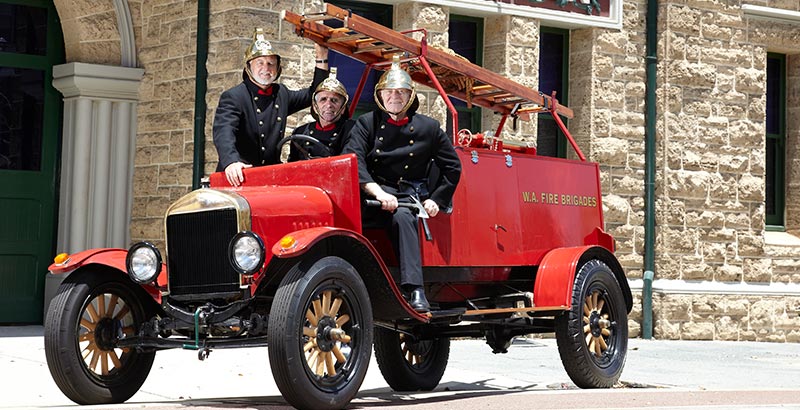
Phone
+61 8 6381 1110
Street Address
25 Murray St
Perth WA 6000
Postal Address
GPO Box P1174
Perth WA 6844